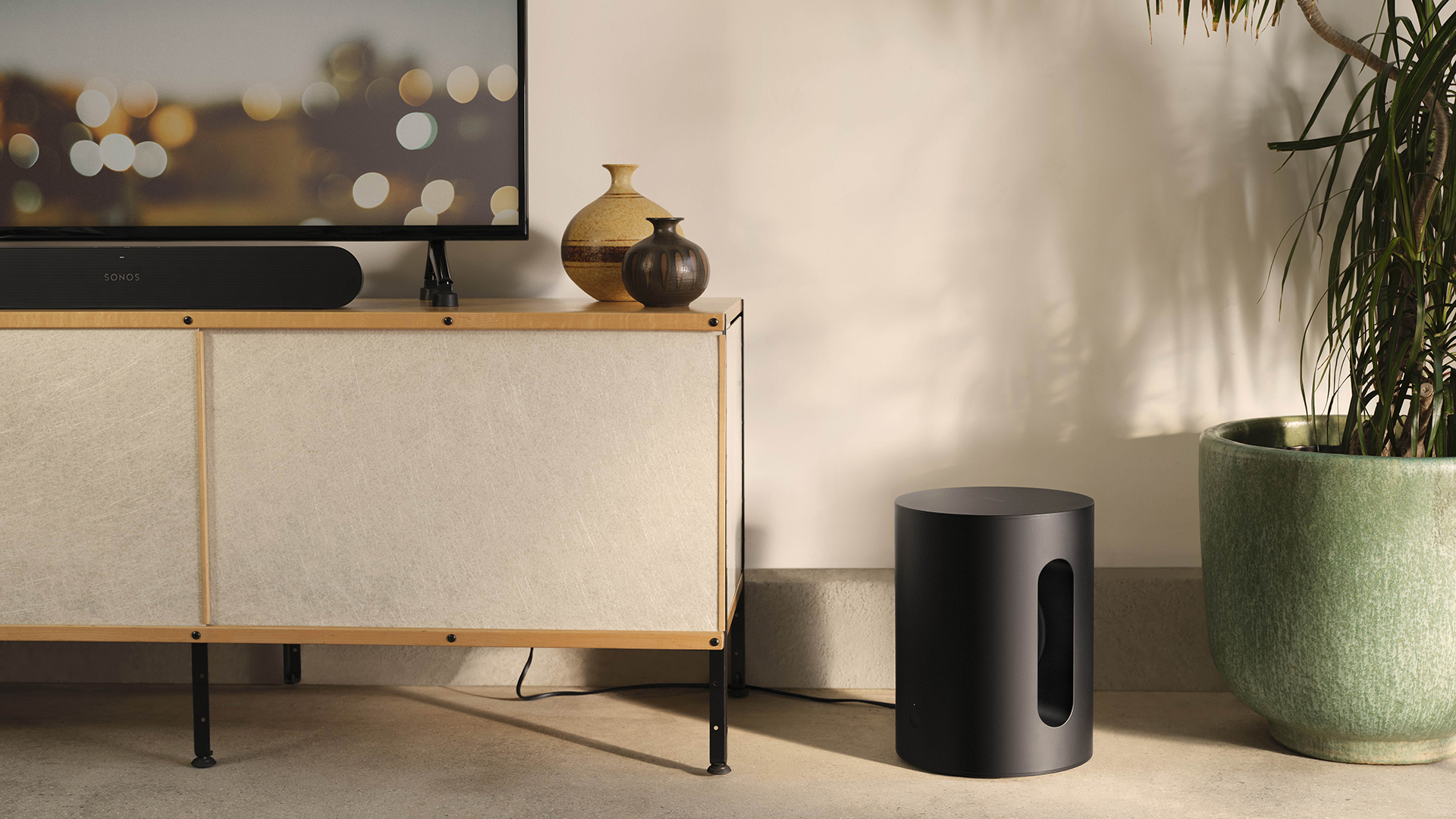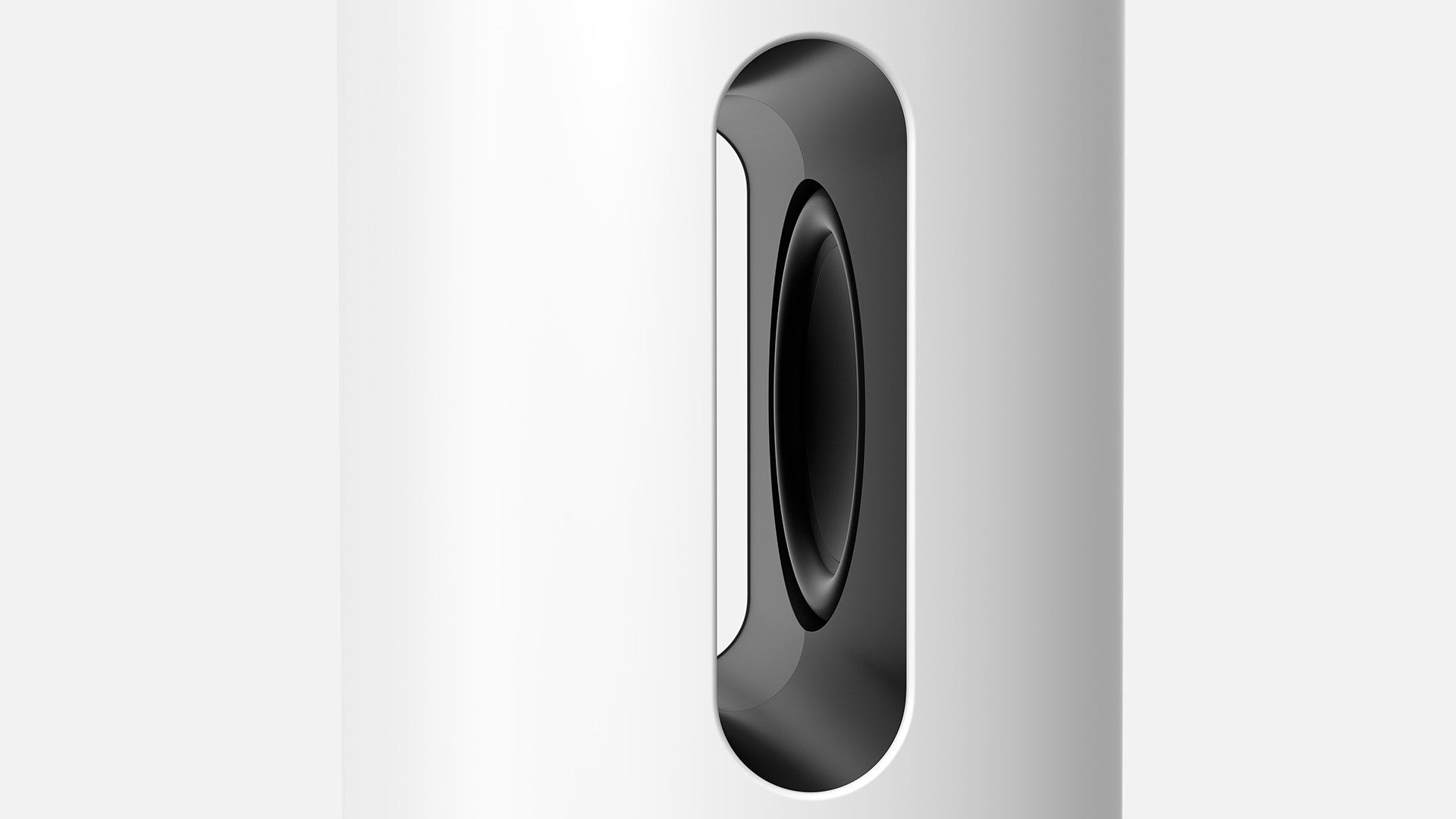Sonos has finally made the much-leaked Sub Mini official, and it looks like exactly the upgrade I've been hoping my Sonos Arc would get, bringing the dual-driver design of the full-size Sonos Sub to a smaller and more affordable version.
The Sonos Sub Mini will be available from October 6, and will cost $429 / £429 / AU$699. It'll be available in white or black, to match with the general Sonos aesthetic.
Its round design is a little different to other Sonos product, but it still fits in nicely with the products overall – Sonos noted to us that the oval cut-out shape is the same shape as the Sonos Beam 2nd Gen and Sonos Ray when they're viewed from above. And Sonos Arc also has a round design, albeit sitting in its side rather than upright.
It stands 12-inches tall, and 9.1-inches in diameter, so it really is a dinky little thing that should be easy to find a place for near your TV. And as you'd expect, it connects wirelessly and seamlessly into your existing Sonos system – Sonos has even added an NFC pad to the top you can tap your phone on, to make it extra-easy to set up. There's an Ethernet port if you prefer that to wireless, though.
Sonos says the Sonos Sub Mini is recommended with Sonos Beam, Sonos Ray or Sonos One units… and says that while it works with Sonos Arc or Sonos Five, they already 'powerful bass' so is less impactful with them. But let's be clear, it will work with any of them, and I suspect that in a situation like mine, it'll be just as well-suited to the Sonos Arc as the smaller soundbars.

I use a Sonos Arc because of its excellent dynamic range and great array of speakers to produce directional sound, but the full-size Sonos Sub is too large, too powerful and too expensive to be a sensible addition in my modest-sized living room. But I do notice the lack of the Arc's bass extension, especially when I compare it to other soundbars I review. I've written about exactly this before, with a Samsung soundbar/sub combo that included exactly the kind of small subwoofer that Sonos has now released.
I think the Sub Mini could be huge among Sub Mini owners for this reason, assuming they do pair well in practice (as I'll find out soon when I test it), and Sonos would maybe miss a huge trick if doesn't promote it to Arc owners, as well as Beam owners. (I am having trouble imagining many Sonos Ray owners opting to buy a subwoofer that costs more than the actual soundbar did – but I will test it with the Sonos Ray too.)
When you connect the Sub Mini to your system, your soundbar will change its sound profile so that the sub can handle the lower frequencies its designed for, and there should be seamless crossover between them – though we'll test that ourselves soon.
Sonos also gives you manual EQ option if you want to adjust how heavily the bass is involved in your setup, and the Sub Mini will work with TruePlay tuning – but you'll need to retune your room if you've done it already.
Analysis: Use the force-canceling
$429 / £429 for the Sub Mini is a little higher than I was hoping for, but Samsung has included the kind of high-end tech that I'd want from a small subwoofer that's going to do its job well, so I can't complain too much.
Like the full-size Sonos Sub, the Sub Mini is designed around a force-canceling dual-driver design. There are two six-inch woofers (each powered by their own class-D amp) that promise to reach down to 25Hz, and they face directly against each other in the center, with the intention that this will cancel out any unwanted additional vibrations.

When you have a big speaker driver – like a woofer – that movies a lot of air through vibration in a forward direction, this causes reactionary vibrations in the opposite direction (ie, into the cabinet it's in). Every action has an equal and opposite reaction. This is what causes a big stereotypical subwoofer to rattle and shake the walls, and it's not good for sound – it's unnecessary.
In a force-canceling design, you have two identical speaker drivers playing the exact same sounds positioned exactly opposite each other. This means that when the vibrations from each one hit the body that contains them, they meet identical vibrations coming from the other way. The two sets of vibrations cancel each other out, so you get powerful sound without the rattle.
This kind of setup means that a subwoofer can be small and relatively light, yet also pack a lot of power, without walking itself across the room from its vibrations.
The only significant downside I'm noting to the Sub Mini so far is that you can only have one unit in your setup, which is a change from the regular Sonos Sub, which enables you to have two in one system. The new Sennheiser Ambeo has pioneered the option of using up to four small subwoofers to give diffused bass around a room without one large unit dominating the physical space, and I hoped that Sonos would provide the same option, but it's not the case. It seems like Sonos would rather that you just spent that money on the big Sub instead.
We're expecting to review the Sonos Sub Mini soon, but if you've got one of the best TVs and a Sonos soundbar sitting under it, it sounds like exactly the upgrade we needed.
No comments:
Post a Comment